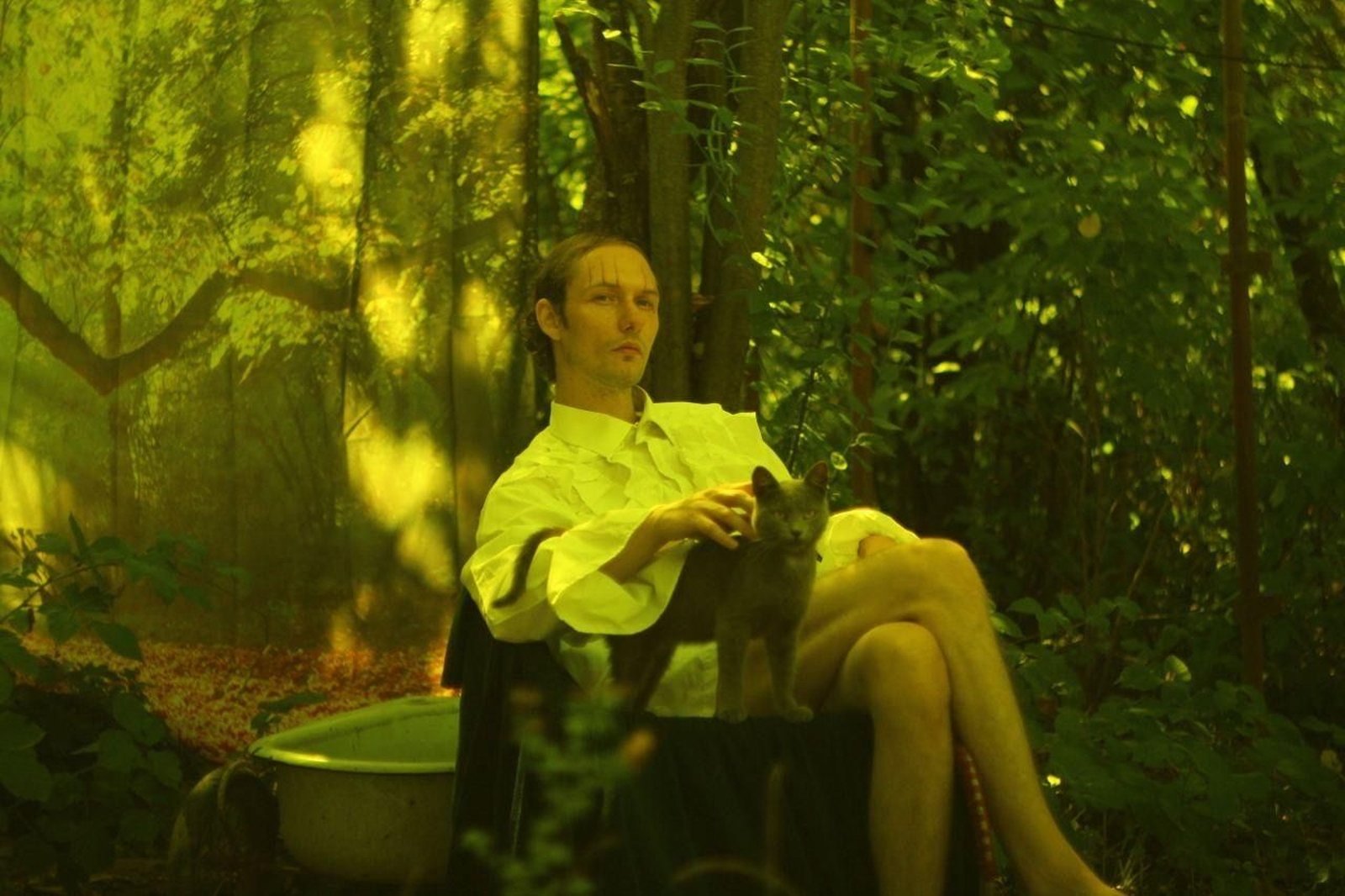Oksana Chornobrova and Maria Noschenko
Where Are We Now, After All Those Endlessly Repeated Words? The title of the exhibition is a quote from Patrycja Plich’s fragmented messages, printed on vinyl and left on lamps at the Hotel Zakarpat’e in 2017, during her stay at the Sorry, No Rooms Available residency. These inscriptions, which are not immediately visible and seem to play hide and seek with the viewers, encourage us to pay attention to the unspoken, the silenced, and the tautological around us. To continue the conversation started by Patrycja, and to reproduce a part of the exhibition here in the text, we have used other passages from her work as section titles.
The combination of words, one Ukrainian and one Russian (Готель Закарпатье), in Hotel Zakarpat’e, the hotel where this exhibition was held, in the city of Uzhhorod, seems to keep the building in the state of constant, incomplete transition. The hotel – a gigantic, gray, monolithic building – seems to have been put on pause or into a deep sleep, and shows no signs of life from the outside. We step inside, carefully following the directions drawn up by curators Daria Shevtsova and Petro Ryaska. The works of the 15 participants: Anna Zvyagintseva, Danylo Halkin, Kateryna Aliinyk, Katya Buchatska, Luka Basov, Maksym Khodak, Marharyta Zhurunova, Bohdan Lokatyr, Natalia Kushnir, Nikita Kadan, Oleksa Konopelko, Olena Pronkina, Patrycja Plich, Sasha Kurmaz, Vasyl Tkachenko, Yarema Malashchuk, and Roman Khimei, are spread throughout the guest rooms, the dimly lit corridors, a conference room, and the greenhouse located on the terrace near the restaurant.
1. Incessant migration is the action of life that flows at each point along the perfect line between point A (departure) and point B (arrival).
The exhibition starts with a kind of introduction to an unprecedented event. Forced to leave our homes, we try to save their images from gradual disappearance by writing the memories down in our diaries and by keeping household objects that remind us of its presence. The characters in Olena Pronkina’s acrylic series Adaptation Diary avoid making eye contact with visitors. They wearily adapt to the new, caught between sleep and recall. The intonation of half-sleep is picked up by Danylo Halkin’s piece Nightlight, which fills the room with caressing light and transforms a strange and unknown space into an intimate one. The sides of the red Soviet lamp depict the now vanished industrial objects of the artist’s hometown, Dnipro. During the forced wartime migration, this ready-made – a part of the artist’s personal belongings – has imparted some qualities of point A to these new places. The work is accompanied by a lullaby that, while inherently soothing, speaks of the indeterminate duration of the situation we have found ourselves in.
Contrasting the surreal domestic scenes from Pronkina’s works, another form of diary emerges. The slide projection of Sasha Kurmaz’s collage series, The Red Horse, combines photos of war-ravaged cities with personal notes and drawings. Despite the shared experience of war, we felt an odd sense of disconnection from what was depicted. Fragments of ruined buildings or leftover bullets are accompanied by the additional colours, cardboard, and tape — materials used only to make the pain look more attractive. The collages leave an impression of pain filtered through the lens of a “Western gaze” (in the sense of perceiving the Other’s experience through a visually simplified, appealing form without plunging into its complexity and multi-layeredness), shaped by the conventions of images prepared for easier consumption in the media. Although the diary format suggests intimacy and genuine emotion, the collages are simplified to a level where they seem impersonal and lacking sincere commentary on what is happening. The stronger side of the work is the way images are shown using a carousel slide projector. The quiet sound produced as slides change complements the lullaby, as images slowly reappear again and again in the relentless cycle of war.
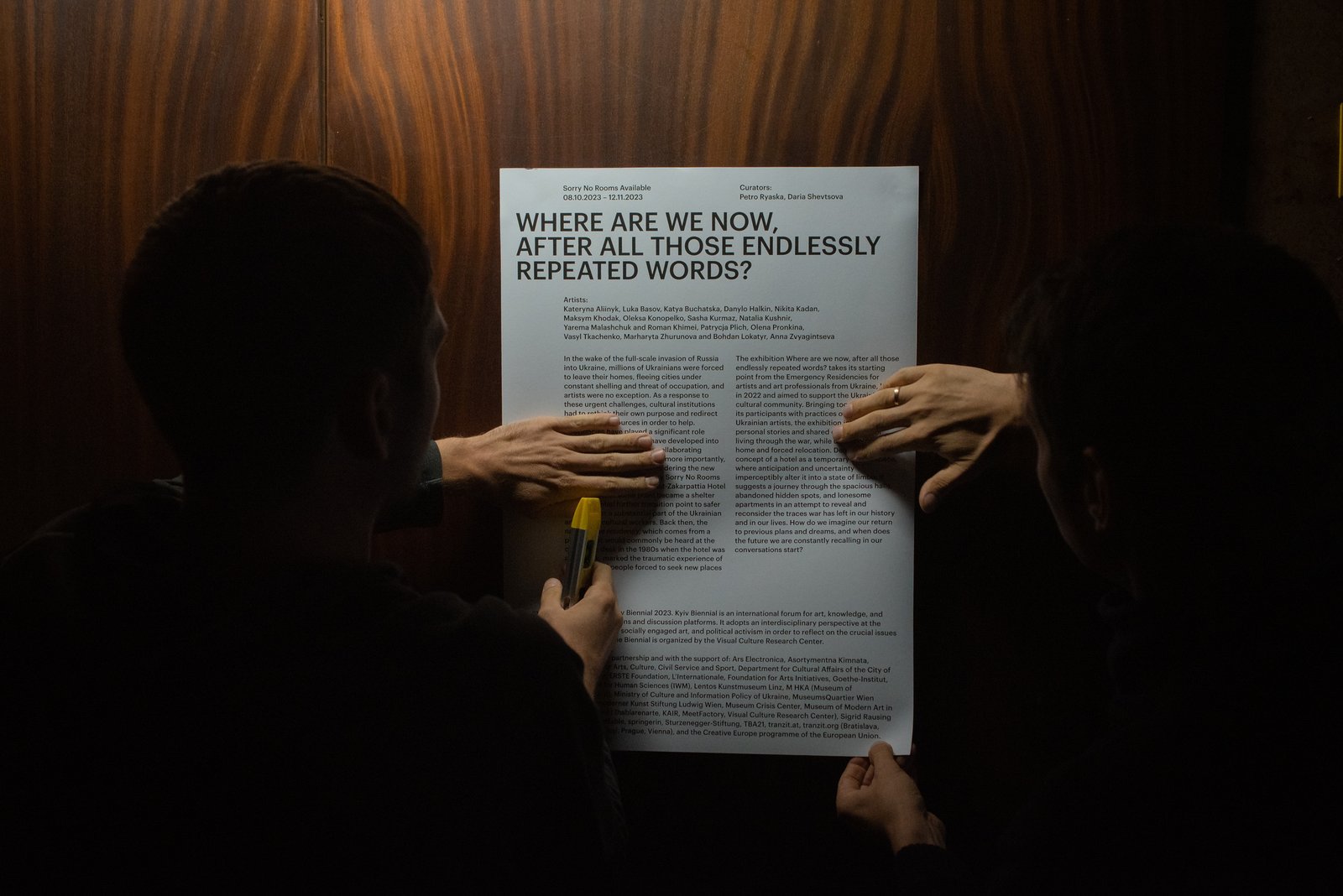
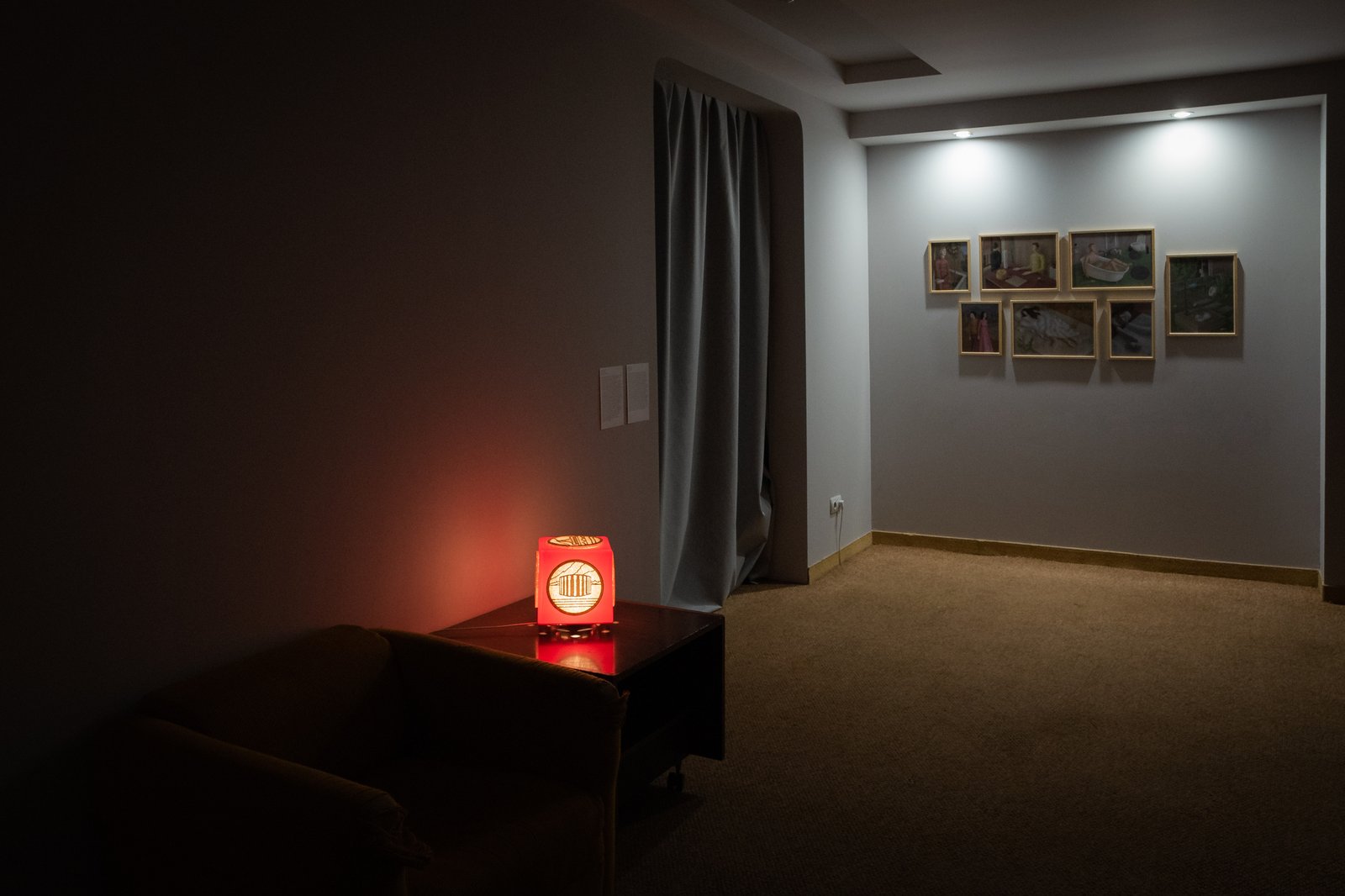
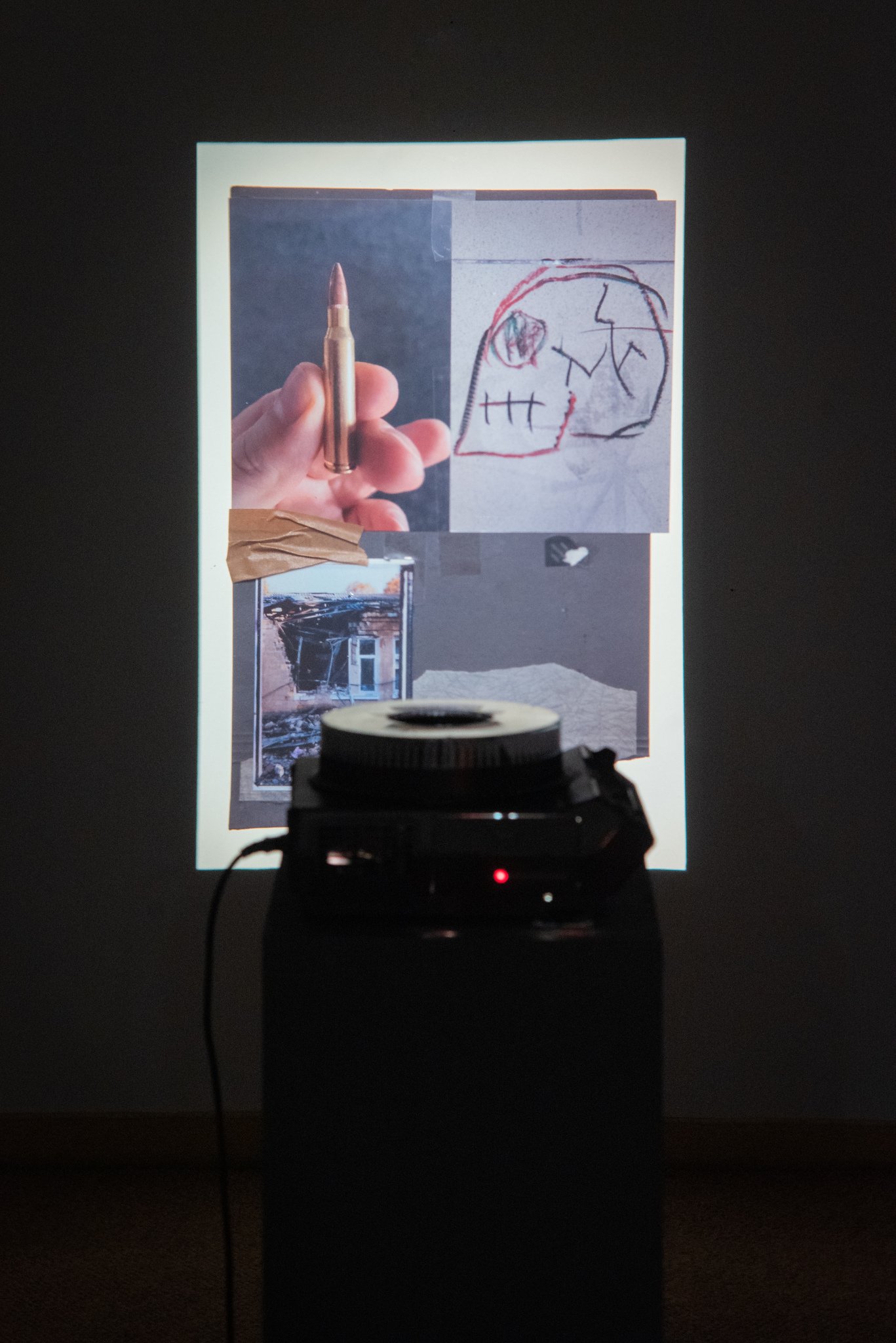
2. Too much too soon. The talking clock – no moment like any other. Attention guided by bodily impulse.
Following directions, we move on and find ourselves in a semi-translucent glasshouse. A cozy and seemingly abandoned space is filled with a peculiar sound: orchestral instruments accompanied by an air raid signal. The sound carries over from a video we will see later.
Inside, we are greeted by Vasyl Tkachenko’s piece 19.07.2023. Turning an old photograph into a painting, the artist superimposed the present-day context – the explosion of the Kakhovka HPP – onto the picture. The work succeeds in capturing how close everyday life is to catastrophe; how we lose track of days (which is why it is so important for the artist to title their work with the dates related to the image), and how the emotional imprint of actual reality and reality experienced through news feeds, with distance, becomes mixed up. Thus, 19.07.2023 gains its punctum (to use Roland Barthes’s term): a prosaically recorded moment reveals to spectators multiple layers of experiences that resonate with each other, leading to disquieting uncertainty. Witnesses unconsciously compare their life experiences with what they saw in order to approach the suffering of others with empathy.
Next, we see Remains, a piece by Marharyta Zhurunova and Bohdan Lokatyr. It consists of printed images and unexpected objects, like a wooden spine and a skull sticking out of a flower bed. The artists bring into view a now painfully familiar semiotic obfuscation: mountains have become mutilated bodies, branches have turned into bones. However, the installation is somewhat visually restrained — black and white prints depicting landscapes shaped like human remains combined with objects that embody quite common images resemble the exposition of an archaeological museum. Yet, thanks to this, the work brings us back from a state of half-sleep to a material reality in which traces of war resemble museum exhibits.
Moving on, we are confronted with Oleksa Konopelko’s video piece Mutafory Lili, with the sound of the sirens which we heard earlier from the glasshouse. Reality provides the setting for a grotesque dream that reveals the emotional tension that exists in the borderline state of the imagination. The initially carefree images of a garden (butterflies, goats, water, and fire) take on a morbid appearance when they mix with the sounds of the air raid siren. A psychedelic journey where fear borders on fascination and reality verges on fiction, this piece becomes the affective highlight of the room.
The glasshouse, through which we can see the outlines of the hotel and the city, reinforces the sense of an uncertain boundary between what is outside and what is inside.

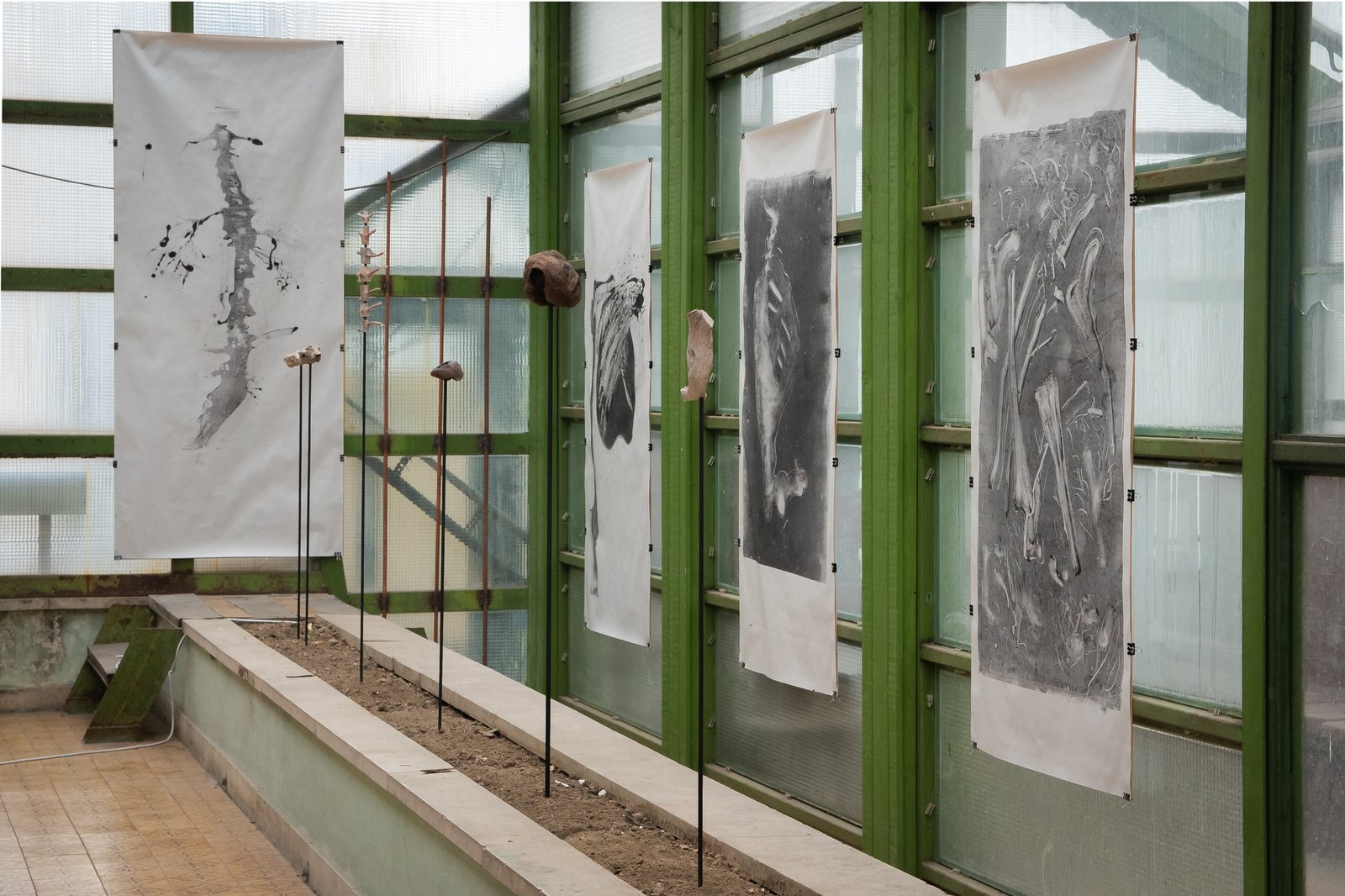
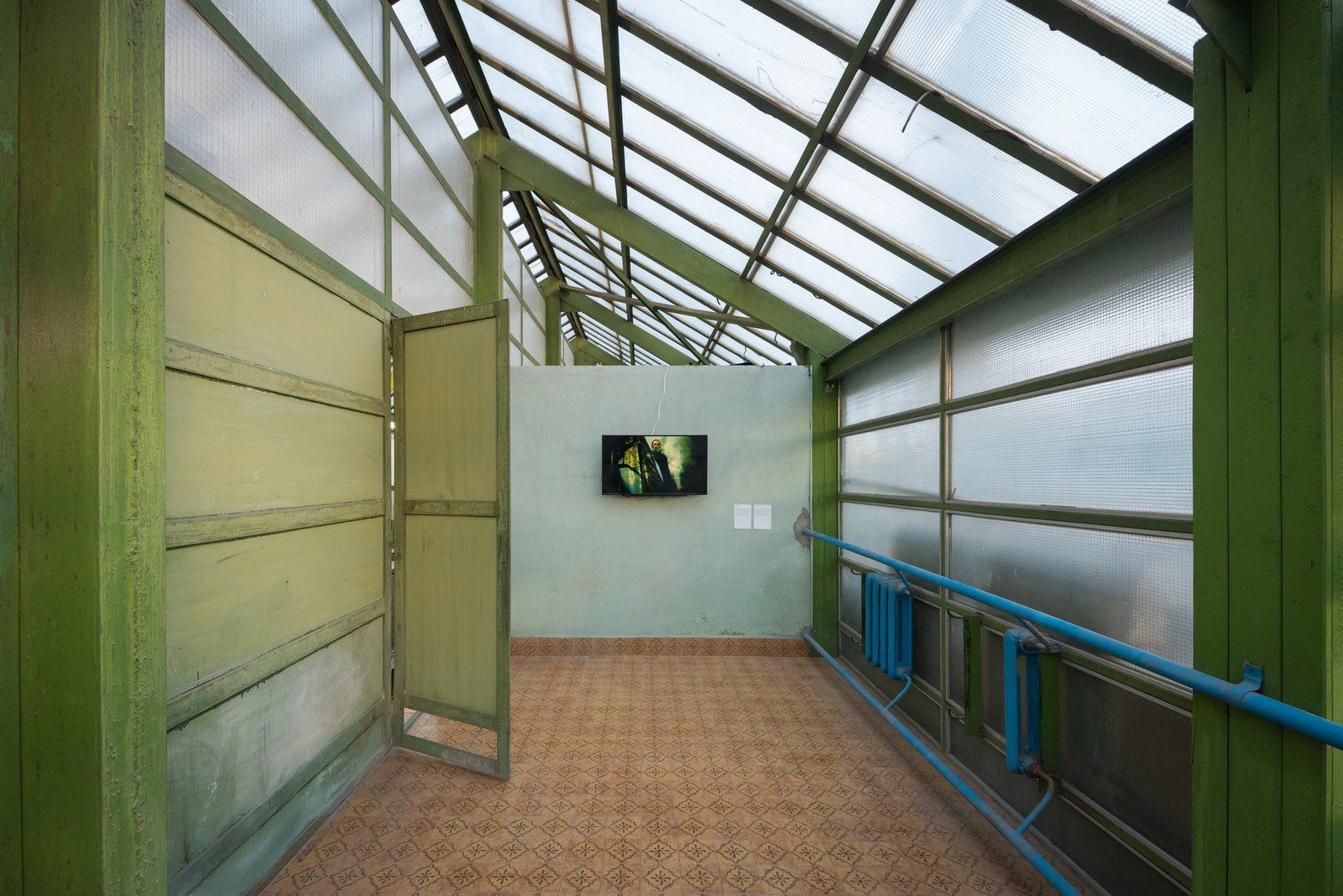
3. Example of the Sun.
The next stage of the exhibition unfolds on the 4th floor of the hotel. Confused viewers walk along the dimly lit corridor trying to find the meticulously hidden art. Patrycja Plich’s Understatement of the Higher Order is placed up above us on the lamps. As we look for the piece, we carefully study the surrounding space. In the middle of an empty corridor, where sullen silence is interrupted by sounds of lovemaking from behind dark wooden doors, we find ourselves in a space resembling a David Lynch movie.
The sentences left as clues by the artist do not add up to a unified story that viewers can try to recreate in their imagination “against the logic of the war.” Instead, these phrases, scattered along the corridor, emphasize the fragmented nature of perception, a result of trauma. “Endlessly repeated words” referenced in the title of the exhibition force the viewer to look inside themselves. To attain introspection, however, we need to abandon a strict rationale.
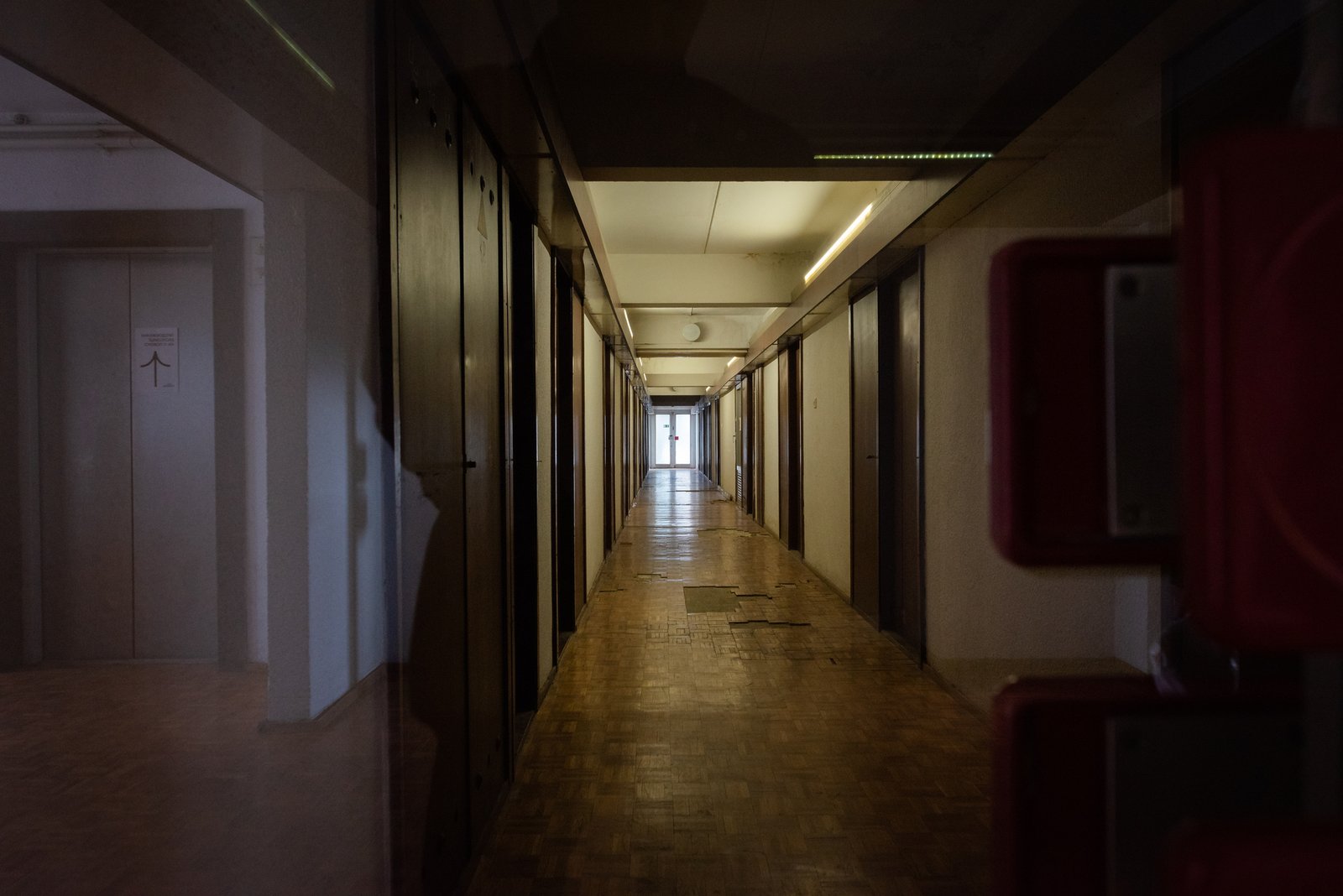

4. This place has a long life.
The lift takes us to the next location, situated on the 11th floor — two interconnected rooms, both entirely painted in grey.
In Kateryna Aliinyk’s painting, Everything Is OK Underground, There Is Always Something to Do, sprawling roots entwine amidst the unidentifiable remnants of a skeleton (maybe animal, maybe human). Nameless bones, just like “skeletal testimonies,”[1] have reached the surface and are confidently sprouting. Indeed, the earth always has something to do. Here, an ongoing process of metamorphosis challenges the notion of frozen memory. Can the earth – constantly engaged in transit, and the transformation of dead, organic matter into nutrients while holding in its depths only a selected number of indigestible items – be a reliable witness?
In the opposite room, we find remains of a different type. Nikita Kadan’s Shawl. Dolyna, both a sculpture and a testimony, is a large-scale, perforated sheet of metal that was found in the half-destroyed village of Dolyna, in the Donetsk region. A bare, monochrome object folded in a gesture of mourning puts us face-to-face with the autonomy of the material, along with its folds and traces of resistance. In a conversation with the artist, Kadan notes that “…mourning here is not in reference to some functional fabric product for mourning ceremonies, but in this act of hanging itself.” As viewers enter and exit room 1114, their vantage point shifts. Initially, we play the role of the victim under fire, but when facing Kadan’s work from the opposite angle, viewers transform into the executioner, peering through bullet holes at bones tinted in a toxic yellow, as if looking at the outcomes (and proof) of their own crimes. This shift in perspective prompts a return to the questions of public mourning posed by Judith Butler: who is granted the right to grieve, and whom are they allowed to mourn?
The image of the earth’s surface covered with the scars of shelling resonates in the photographs of the fields of Moshchun in Katya Buchatska’s video This World Is Recording. Once again, the earth becomes an active participant in the act of commemoration. The artist leads us through an imaginary memorial garden planted in the craters made from bombing, and just like empty pedestals, provides space for new monuments while simultaneously disappearing in the process of their emergence. The traces of war crimes gone, buried beneath the soil, evoking a call to remembrance even though they have completely disappeared. The anamnesis garden, although retaining an implicit understanding of its own fragility, rids itself of the “aggressively present past” and attempts to “deblock”[2] the future. The video project of the garden is not about glorification or memory-as-warning, rather it aims to increase the value of the future “so that we have something to lose.” The death of the garden is hardwired into the project from the very beginning, and is how the garden acquires meaning and importance, through the cycles of its existence.
Three ceramic sculptures displayed in the corner, on the opposite side of the room, are Maksym Khodak’s work Empty Pedestals. Miniature replicas of WWII tank monuments from Ukrainian cities labeled as “Hero Cities” sit atop pedestals and are accompanied by framed appeals for donations. But in Khodak’s replicas, the tanks, originally intended to heroize the “collective” victory over fascism in the Second World War, are disappeared from the monuments. A hole for donations exists where the tanks should be. Unlike a typical piggy bank, the money is trapped within an artwork that is indestructible due to its cultural significance. The artist continues the discussion started by Hito Steyerl in her text “A Tank on a Pedestal: Museums in an Age of Planetary Civil War,” and makes us ponder how effective art and cultural institutions are during political collapse. Wartime art becomes a functional object, a direct action that prevails over other forms. In its stead, the display of emptiness raises an open question about the alternative to a “demolished” history. According to Claude Lefort, the totalitarian system triumphs by filling the empty place of power. Perhaps we should leave the pedestals empty to protect ourselves against further totalitarian claims to a singular historical truth?
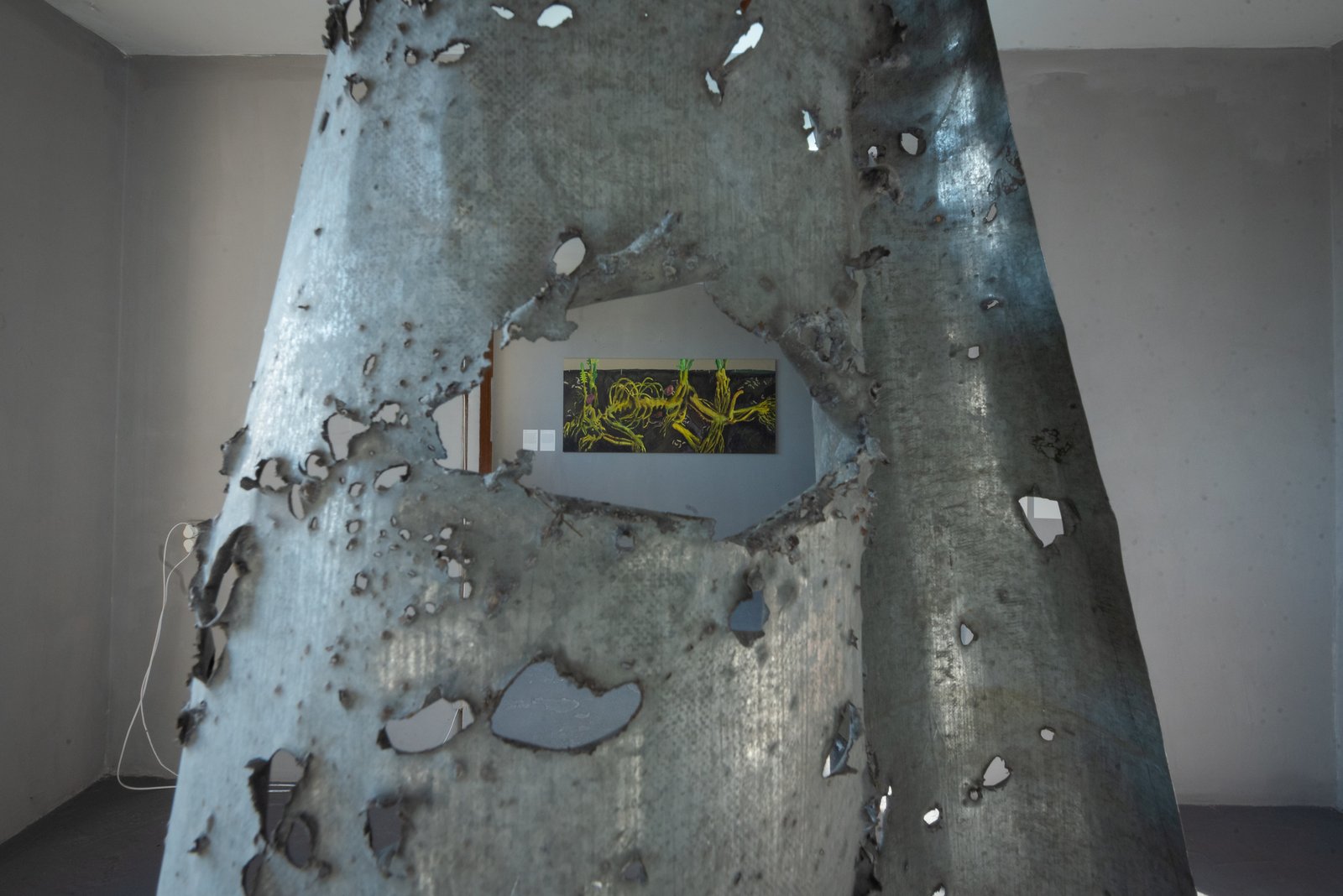

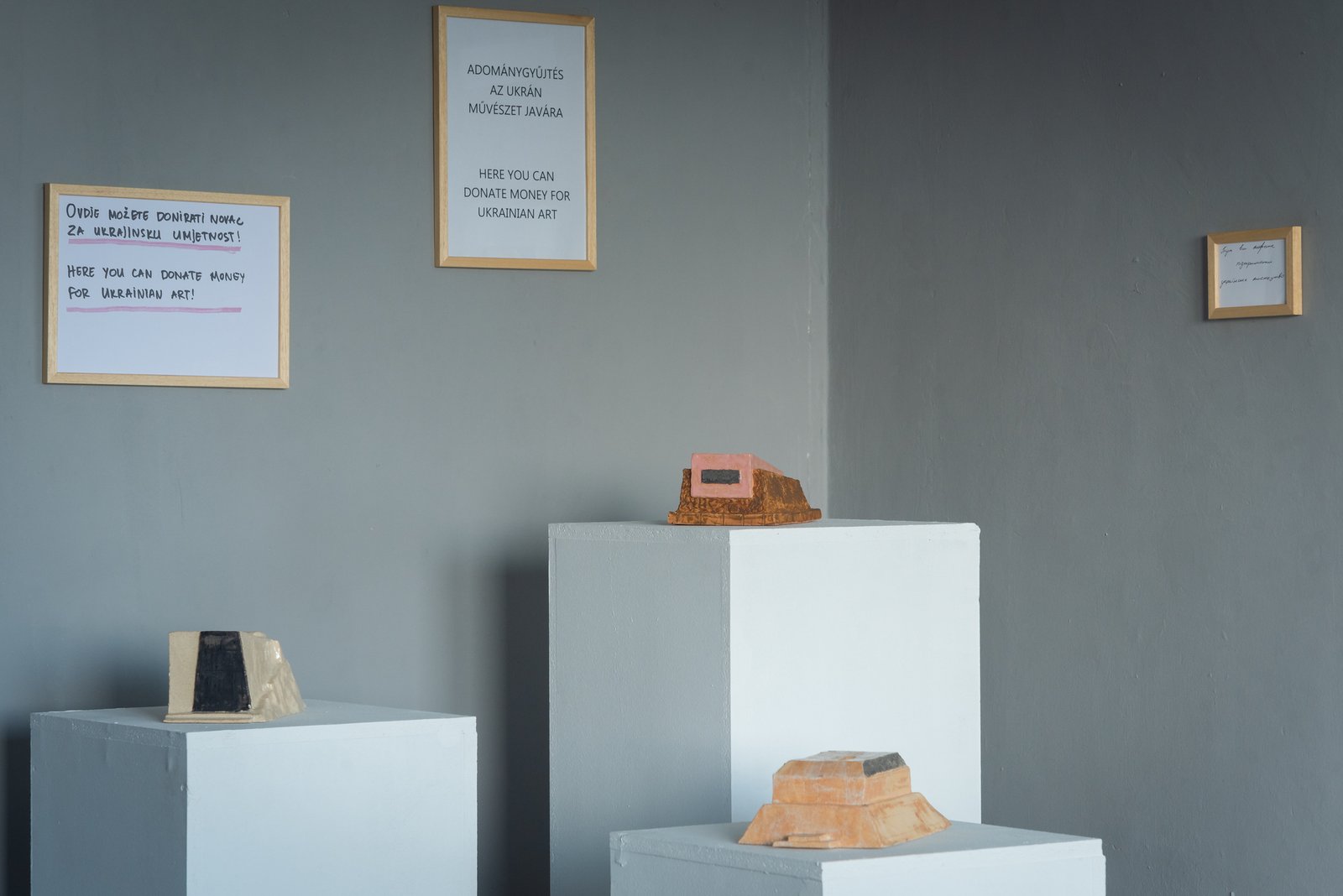
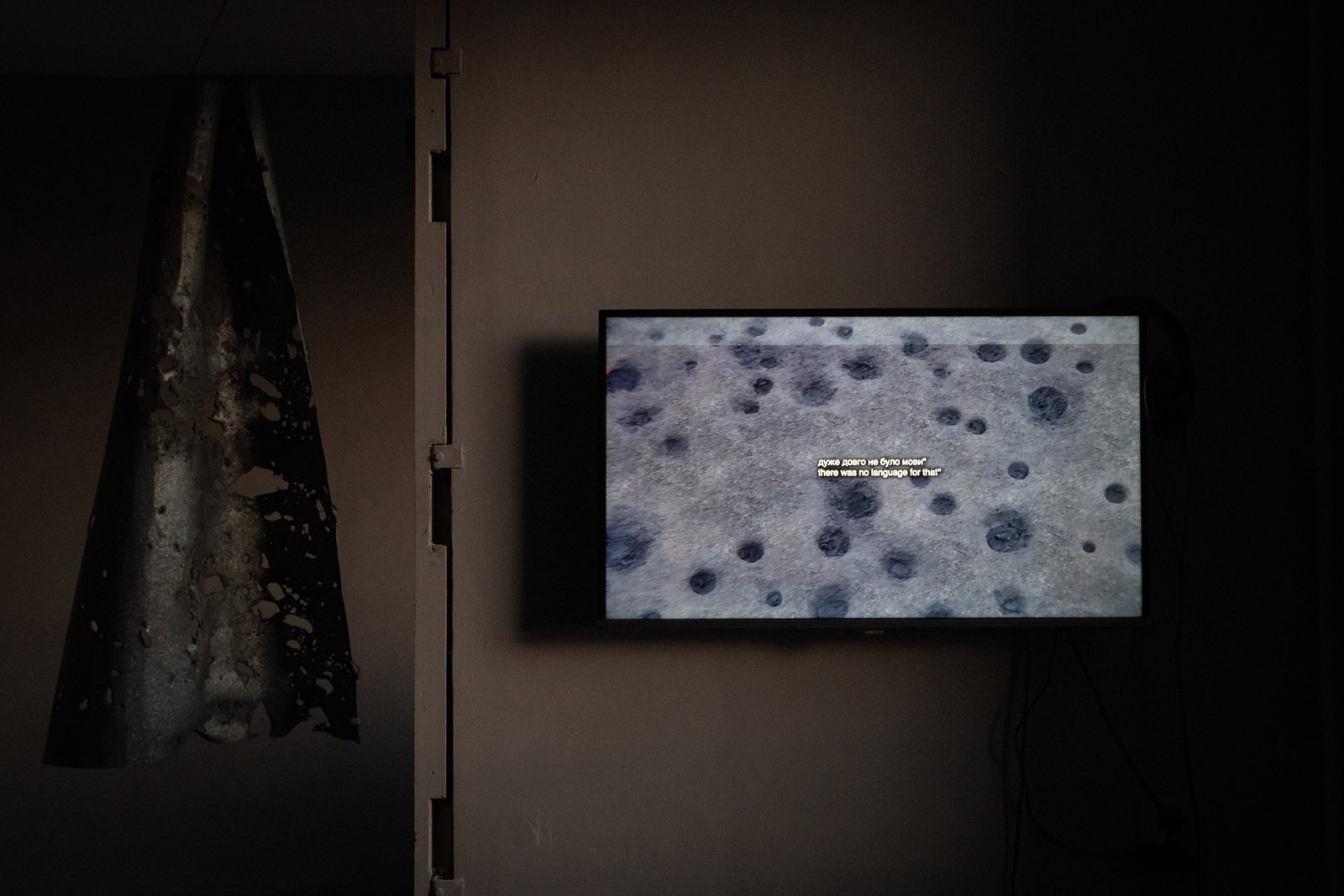
5. You created this bleak world so you could hide. Here, in this eccentric loneliness.
The 13th floor (marked as the 14th) offers the viewer two choices: going right, we find black-and-white paintings, images of darkened interiors and people with their backs turned towards the viewer. Luka Basov’s series Emergency Exit into My Dream line the dead-end corridor and induces claustrophobia-like anxiety. The curators suggest that we should face the fear we routinely suppress to continue functioning. Tellingly, this room is easy to bypass, just like the horrors that, deeply embedded in our psyche, imperceptibly yet significantly changes us. On closer inspection, Emergency Exit into My Dream defies the overarching logic of the exhibition. The work refers to more generalized images of the macabre – reminiscent of horror films – which result in the same generalized and somewhat entertaining fear provoked by fiction. War, and the fear it generates, is unfortunately more powerful than any film.
Moving on, we enter a small room. Before us is Natalia Kushnir’s installation Someone, which is a tiny clay replica of the hotel room, complete with small ceramic objects on minimalist furniture, a TV, and lamps covered with pictures. Comparing the ceramic reality to the real one, we accept the artist’s invitation to play the game of “spotting 10 differences.” We realize that the hotel room has been abandoned; all that remains is to reminisce obsessively and try – in vain – to touch objects that have left behind nothing more than an imprint in the dust. However, a clear picture is undermined by the presence of the objects missing from the smaller version of the room. Only later it becomes clear that the artist has added some elements of the installation to tell the story not only of someone lost, but also to indicate her own presence. Thus, a connection to what is lost appears; we witness the emergence of a kind of hope yet ultimately also feel the absurd cyclicality of it all.
It should be noted that the piece lacks formal precision: its subtle meanings are not clear immediately upon our interaction with the piece, thus leaving us with a rather muddled impression. Meanwhile, this part of the exhibition constitutes an important point on the map. To move forward, viewers must allow themselves to experience the despair of loss and integrate it into their own story.


6. You’ve reached the end. And we’ll act as if it’s just an unfortunate mistake we’ve made.
Returning to the corridor and taking the opposite direction, we enter the last room.
Willow branches sprout from a bucket in the corner of room number 1416. On the wall nearby we see a photograph of a stick standing in the middle of a field, like an obelisk. The photo illustrates a note from the artist’s grandfather: “Like a tree without leaves, my soul stands in the fields.” Anna Zvyagintseva’s piece To Plant a Stick presents us with a simple yet profound gesture of memory. The branch endures in its growth, quietly revealing the continuum spanning from yesterday through today and into tomorrow. We pay our respects so that we wake up, so that plant roots grow and tangle, new shoots appear, and leaves sprout.
So That Nobody Would Later Say We Don’t Remember, a video piece by Roman Khimei and Yarema Malashchuk tells the same story – a field, a person, a loss – yet expanded to the collective scale. Hidden under the surface, coal seeded the steppe beneath the city of Myrnohrad, which was built in the middle of a grassy landscape out of two mining villages in the Donetsk region. In 1977, there was a tragic accident at the Novator mine which led to its closure. Today, the earth covers the human traces with thickets and bushes, thus reminding us of its resilience. The artists document movement through the city as a reconstruction of its past: locals and participants of the Landscape as a Monument[3] residency walk through the single-industry town, recreating the route from the mine shaft to the monument commemorating the loss of life. We find ourselves in the middle of a geography of coexistence; each step closes the distance between the visible and the invisible, the remembered and the forgotten.
As we leave the room, we see an excerpt from the Cossack song “Over the Blue Sea,”[4] as well as two small works by Aliinyk, depicting the tubers of perennial plants, usually hidden in the soil. The works continue the tone of hope by manifesting the continuation of growth and life despite any threats to stop it. Stems accumulate nutrients to produce new sprouts once the adverse conditions pass. Instead of a final point, the end of the exhibition leaves us in the middle of incessant movement. “Where Are We Now…?” — we continue to grow, mutate, and move. Hoping for revival and return, we turn to the past and look into its roots.
Where Are We Now, After All Those Endlessly Repeated Words? acts as a guide, leading us along a knotty path of feelings that resist clear identification or hide as far as possible in the hopes of becoming invisible. Unlike many exhibitions that happened in Ukraine in 2023 that claim to be introspective, Where Are We Now…? actually asks the viewer about their condition in the midst of a long war, and most importantly, provides the space where answers can be found.
Spread throughout the hotel, the physical distance between different parts of the exhibition allows us to have some time to ourselves and to choose the punctuation marks we want to place between these repeated words. Already tautological experiences of despair, hope, confusion, and gratitude are revealed in a subtle way that considers almost imperceptible mental processes, which prompts viewers to pay attention to both the details of the exhibition and the nuances of their experiences.
While the curators have subtly demonstrated how war occupies the most intimate zones of existence, layer by layer, seeping into and appropriating both the conscious and the unconscious, the show can feel a little flat due to the uniform emotional tone, which reaches its peak in the last rooms. At the same time, total monotony is avoided as the curators address different aspects of similar conditions and problems, and implement diverse visual and spatial decisions. Devoid of didacticism, excessive pathos, or claims to exhaustive representation, the exhibition carefully approaches the visible and the invisible, the real and the imagined, the past and the future to ultimately reveal that which is hidden.
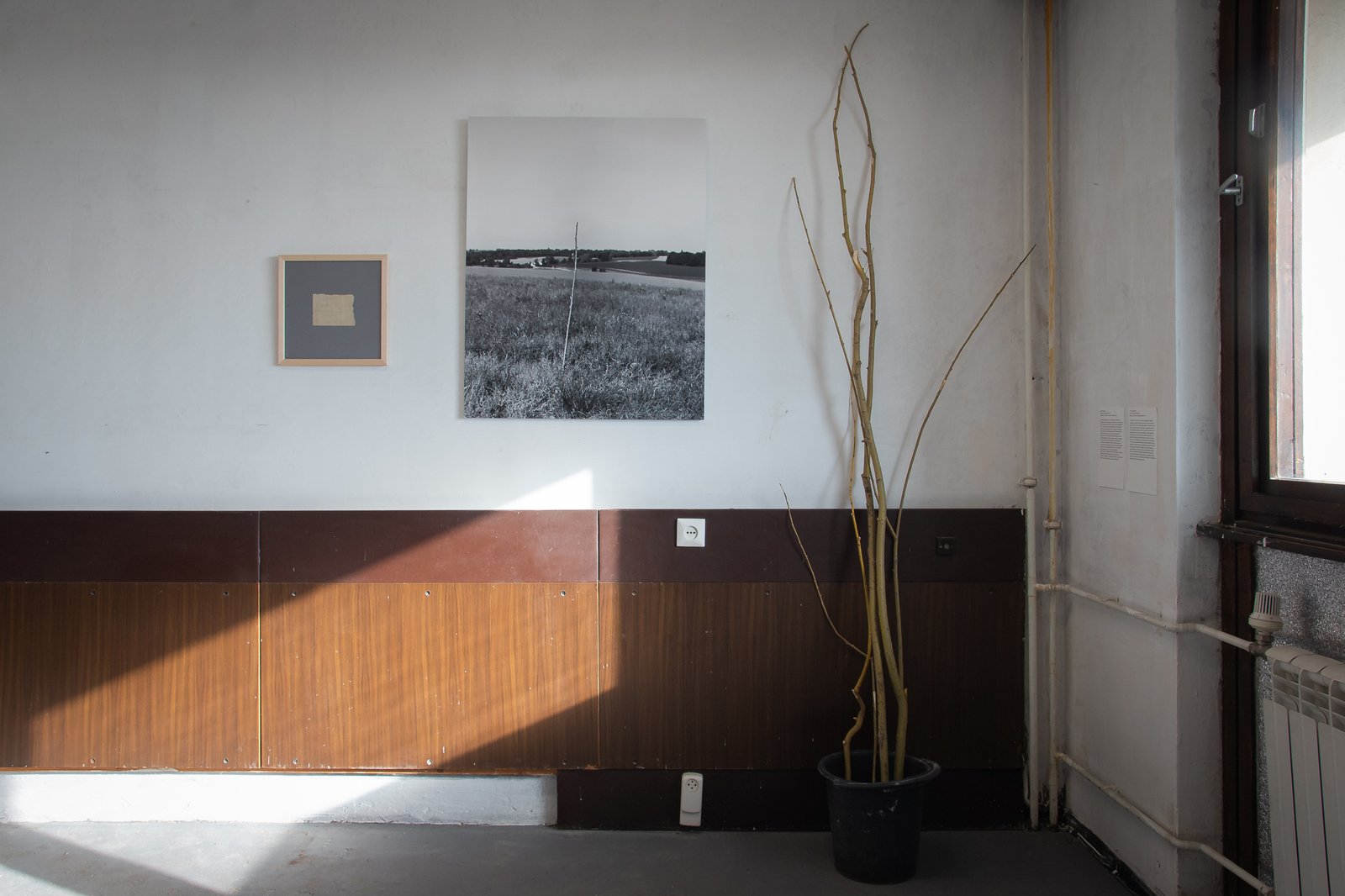

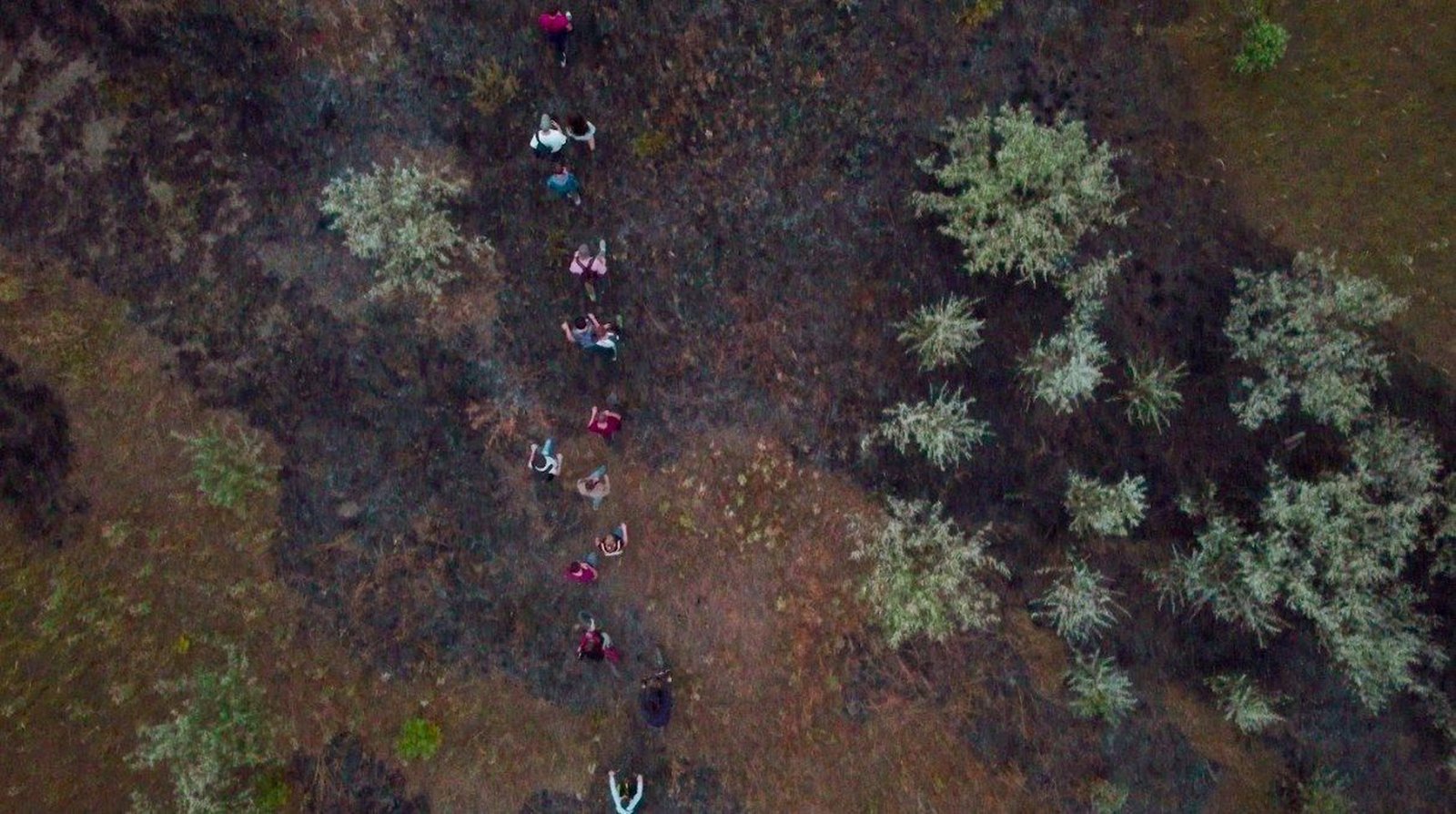
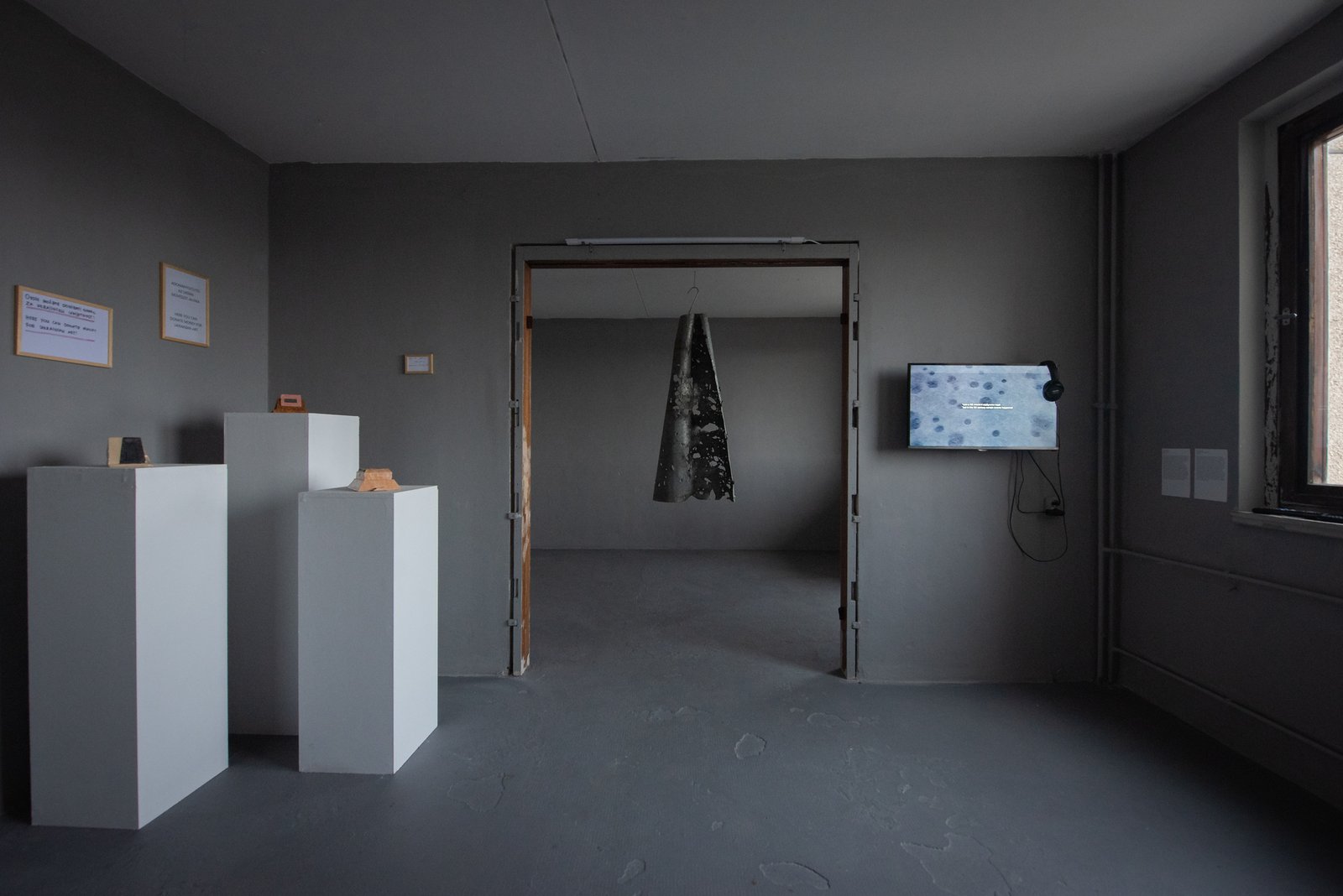
[1] A quote from a poem by Yanis Sinaiko spotted at the exhibition On Loss in Lviv Municipal Art Centre
[2] According to Hans Ulrich Gumbrecht, the future is shaped and “blocked” by the pervasive influence of concerns and anxieties about the potential threats.
[3] Landscape As a Monument A-I-R Programme https://izolyatsia.org/en/project/landscape-monument
[4] English translation to the song “Over the Blue Sea” https://www.dailymotion.com/video/xkmvnm
Artist(s): Anna Zvyagintseva, Danylo Halkin, Kateryna Aliinyk, Katya Buchatska, Luka Basov, Maksym Khodak, Marharyta Zhurunova, Bohdan Lokatyr, Natalia Kushnir, Nikita Kadan, Oleksa Konopelko, Olena Pronkina, Patrycja Plich, Sasha Kurmaz, Vasyl Tkachenko, Yarema Malashchuk, Roman Khimei
Exhibition Title: Where Are We Now, After All Those Endlessly Repeated Words?
Link: https://2023.kyivbiennial.org/eng/program/where-are-we-now-after-all-those-endlessly-repeated-words
Venue: Hotel Zakarpat’e
Place (Country/Location): Uzhhorod, Ukraine
Dates: 08.10.23 – 12.11.23
Curated by: Petro Ryaska, Daria Shevtsova
Photos by: Sasha Kovalenko

